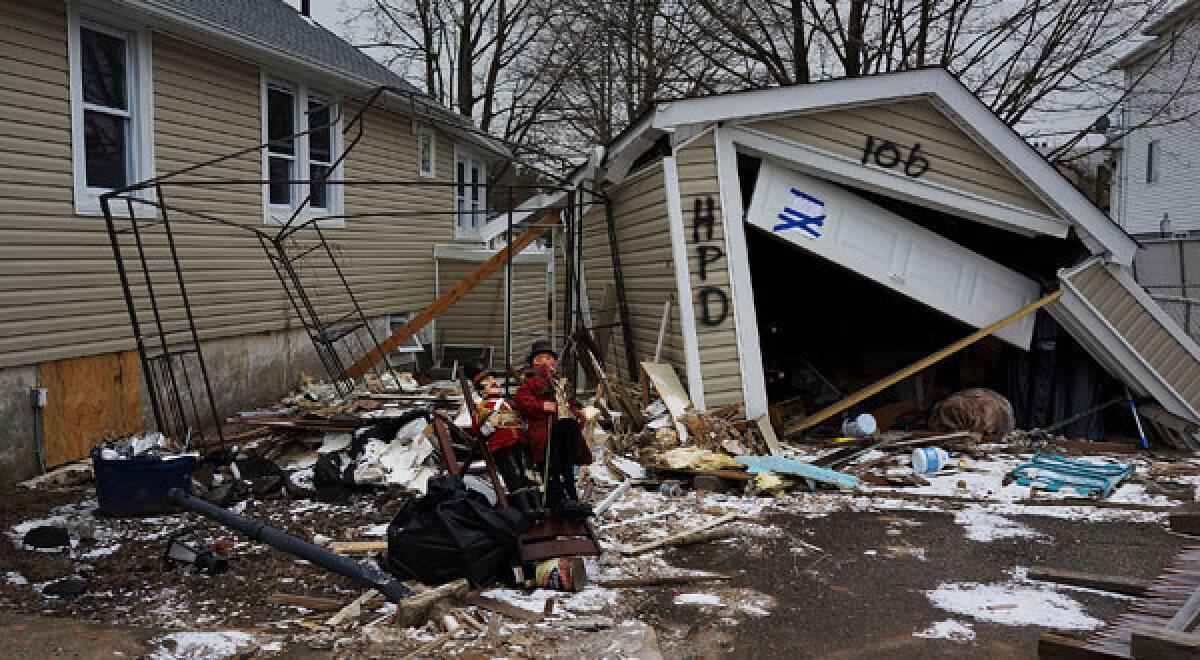Sandy was region’s deadliest storm in 40 years, report says

- Share via
Superstorm Sandy earned its name, the National Hurricane Center reported on Tuesday, in a report that says the storm was the deadliest to hit the region in 40 years and the second costliest in the nation’s history.
The report summarizes last fall’s traumatic weather event, whose effects are still being felt. During the recent blizzard, one of the concerns was whether there would be more flooding to regions still recovering from Sandy’s visit. Politically, reconstruction will likely take years and some needed infrastructure improvements to low-lying areas may take longer.
Sandy is described in the report as “a classic late-season hurricane in the southwestern Caribbean Sea” that wreaked havoc.
“Preliminary U.S. damage estimates are near $50 billion, making Sandy the second-costliest cyclone to hit the United States since 1900,” the report notes. ”There were at least 147 direct deaths recorded across the Atlantic basin due to Sandy, with 72 of these fatalities occurring in the mid-Atlantic and northeastern United States. This is the greatest number of U.S. direct fatalities related to a tropical cyclone outside of the southern states since Hurricane Agnes in 1972.”
PHOTOS: Hurricane Sandy
More than 120 deaths in the United States were attributed to Agnes. The deadliest hurricane in U.S. history hit Galveston, Texas, in 1900 and killed 8,000 to 12,000 people.
Katrina, the modern standard for deadly hurricanes, was responsible for an estimated 1,833 deaths, many of which were attributed to the flooding caused when the levees protecting New Orleans were breached. Katrina in 2005 caused at least $108 billion in damage, the equivalent of more than $128 billion in current dollars.
Sandy began as a tropical wave off of the coast of Africa on Oct. 11, according to the report. It reached the Caribbean on Oct. 18 and grew into a hurricane by Oct. 24 before it weakened and regained power, again becoming a hurricane as it reached the United States where it merged with another storm front and pounded New Jersey, causing record flooding. Some 24 states felt Sandy’s wrath by the end of October.
At its peak, the storm brought fierce winds as it spread to a diameter of about 1,000 miles. More than 650,000 U.S. homes were damaged or destroyed by the storm, and more than 8 million customers lost power, according to the report.
The highest storm surges in New Jersey were 8 1/2 feet over normal levels at Sandy Hook, though it likely was higher because the storm knocked out the gauges, according to the report. The highest surge in New York was more than 12-1/2 feet at Kings Point on the western edge of Long Island Sound.
ALSO:
2 held without bail in Hadiya Pendleton shooting
SEAL sniper Chris Kyle gets farewell at Cowboys Stadium
Former Californian Clint Romesha gets Medal of Honor for valor
More to Read
Sign up for Essential California
The most important California stories and recommendations in your inbox every morning.
You may occasionally receive promotional content from the Los Angeles Times.














